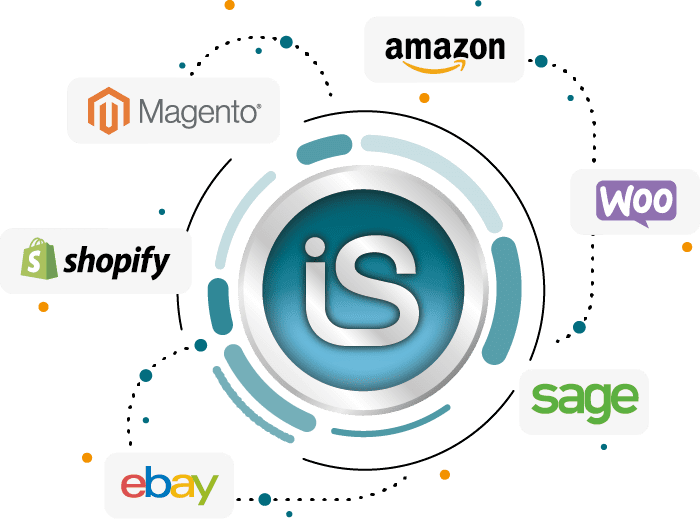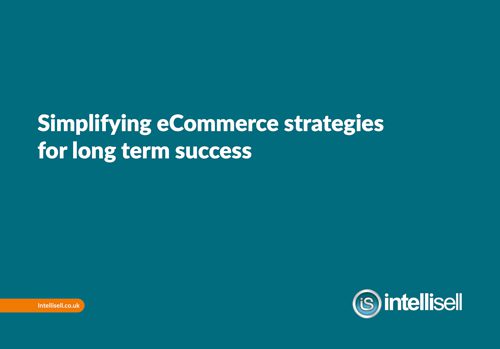Sage eCommerce for manufacturers
Service and grow your business with Intellisell

Watch
How does Intellisell support your manufacturing operations?
Sage eCommerce for manufacturers
Whether servicing existing customers or considering an expansion into new channels, Intellisell can support your operational demands. Automation of labour-intensive processes across your business improves workflow and minimises errors, making your entire operation more competitive.
Intellisell works with your Sage system to build a foundation for any ‘to consumer’ expansion. Critically, it delivers the real time assessment and analytics to move more quickly and track your progress against objectives.
Test new products in new channels
Intellisell works with all of the leading marketplaces and can easily integrate with the latest platform. From Amazon, eBay and Wayfair to social ‘buy now’ capability, we can help you turn on and trial new opportunities.
Improve visibility over operations
Dashboard view of operations delivering affordable, cloud-based information to the whole business immediately.
Re-imagine fulfilment for the individual customer
Connect shop-floor, warehouse, logistics and service departments to improve efficiency and lower costs. Minimise fulfilment mistakes for smoother overall service.
Enrich and automate product information easily
Use existing Sage product data to easily build out product descriptions, images, video and attachments for your eCommerce site or new online channels.
Sage integration as standard
Written for Sage ERP, Intellisell uses the power and logic of your Sage 200, Sage 1000 or Sage X3 solution to integrate end point solutions across your organisation.
Intellisell
Some of the partners we work with

D2C and M2C strategy support
Post-pandemic and post-Brexit the world of manufacturing has changed. UK companies are facing unprecedented supply chain issues, skills shortages and increased competition from overseas. Consumer demand has changed too. Almost 61% of all B2B transactions started online in 2020 and the trend for online purchase is only going up. Engaging directly with the consumer through a D2C (Direct to Consumer) to M2C (Manufacture to Consumer) model is now a necessary play in the UK manufacturer’s strategy.
Find and attract new customers to your portfolio. With out of the box integration into global marketplaces such as Amazon, eBay or Just Eat, Intellisell can give you an agile platform to test new products and scale your operations. Once you have attracted them and converted them to loyal customers you can divert them to but via your own website, lowering costs and improving control both before and after purchase.
Complementary partners
Intellisell works with a range of complementary solutions, we can help you to expand the functionality of your eCommerce platform in line with your growing business.
Pimberly is just one of the partners that we work with. Product Information Management (PIM) software handles complex product data and digital assets in a central platform. This is vital for enabling brands, manufacturers, distributors, and retailers to work from a single source of truth.
See how important product data is for your B2B growth by watching our joint webinar with Intellisell product expert, Richard Nash and customers from Pimberly.

Call us on 0344 880 6140
or chat with an expert.
Want to book a consultation with an eCommerce expert in manufacturing?
General Contact Form
Intellisell integrates with Sage

Sage Intacct
Let Sage Intacct and Intellisell do more of the heavy lifting. Automate tasks across your business to improve workflow and increase efficiency, saving time and minimising errors.
Sage 200
Used as an integration platform you can connect departments to Sage 200 making you more efficient and flexible to changes in customer demand or new
opportunities.
Sage X3
Intellisell integrates with your Sage X3 solution to manage your complex business requirements, multi-site operations and global compliance.
Sage 1000
Accelerate your business online with multi-channel web analytics and Sage 1000 data combined you can drive improved decision-making.
Resource Centre
Top 6 trends driving eCommerce in 2023
We are in a post-pandemic society, where consumers are in charge of 'when' but also 'how' they shop, so what does the priority look like for the year ahead? Consumers want a consistent product...
Intellisell FAQs
Anyone interested in integrating Sage solutions with their eCommerce applications, marketplaces and channels will have questions. Businesses will want to ensure that they’re connecting the right...
Intellisell’s integration with Ravensden’s Sage ERP 1000 software
Ravensden wanted to provide its customers with an alternative method of ordering that was fast and reliable, to showcase its wide product range. With such a broad range of products in Ravensden’s...
Top 6 trends driving eCommerce in 2023
We are in a post-pandemic society, where consumers are in charge of 'when' but also 'how' they shop, so what does the priority look like for the year ahead? Consumers want a consistent product...
Intellisell FAQs
Anyone interested in integrating Sage solutions with their eCommerce applications, marketplaces and channels will have questions. Businesses will want to ensure that they’re connecting the right...
FAQs
What is an eCommerce system or platform?
It is a system that enables electronic payments online. There are different ways that merchants can offer these payments. Some choose to offer fully integrated software solutions or third-party systems managed by service providers such as PayPal and WorldPay.
Many components make up an eCommerce system. These features could include; the shopping cart, integration capabilities, and security infrastructure. Each offers an important part in making sure that the system runs efficiently for both the merchant and their customers.
eCommerce integration involves implementing a shopping cart, merchant accounts, payment gateways, and security mechanisms with your website. This all helps to provide the merchant with an eCommerce system and a seamless shopping experience for the end customer.
So if we think of the software as the engine behind the scenes of an online store, then the system enables electronic payments. The software manages inventory, allows you to add or remove products, calculate the charges, order fulfilment etc.
By way of showing a friendly user interface people from non-technical backgrounds can manage the entire eCommerce operation. The back end of the interface is very multifaceted and a complex machine.
Any viable eCommerce software will enable customers to buy your products and services from your online store. Where solutions differ is the degree to which they can unify and leverage both front and back-office applications with both their unique and shared data. eCommerce platforms provide the unification of core business processes, where businesses can gain complete visibility across their company and ultimately meeting their most discerning customers’ expectations.
An eCommerce platform should allow for integrations between separate systems including; accounting, POS, inventory and order management, marketing, merchandising, customer service and financials on a cloud-based platform.
The benefits of having the software integrated allows you to provide reliable, consistent and personalised cross-channel experiences. You can offer superior customer service through a single view of all interactions and transactions across all touchpoints and channels.
You can also go above and beyond your customer expectations and increase your revenue by taking control of your orders and have one single view of what inventory you have across multiple channels and supply chains.
What are the most common types of eCommerce Software?
On-Premise: These are managed onsite by developers who take control of the manual updates and carry out any fixes that may need to be resolved. It offers merchants flexibility over hosted solutions. However, SaaS is becoming the preferred option, which you can discover more about below.
SaaS: Software as a Service (or “hosted”) solutions are much more detached from developers, in simple terms it isn’t maintained through company hard drives, you access it via the internet
The only requirements from development teams are usually for supplementary custom design features. You will be able to action any updates with one click or they happen automatically. This makes it a better choice for online merchants. It saves time for eCommerce stores using SaaS software and it’s also so much cheaper than on-premise solutions.
What is an Enterprise Resource Platform (ERP) eCommerce integration?
This is referring to the automation between the back office and the website. Automatic updates of product, price, stock and then the processing of customer and order details.
What is a payment gateway?
A payment gateway is a technology used by merchants to accept debit or credit card purchases from customers. So once you hit the buy button on a website, the payment gateway comes into action.
The next step is adding your bank card details. It is the front-end technology in charge of sending customer information to the merchant acquiring bank, for processing.
It then returns the transaction details and response from the payment network to the website you purchased from to inform them that the card is authorised, and therefore the order is completed.
In physical stores, payment gateways consist of the point of sale (POS) terminals used to accept credit card information by card or by smartphone. In recent years have begun accepting phone-based payments using QR codes or Near Field Communication (NFC) technology.
In online stores, payment gateways are the “checkout” portals used to enter credit card information or credentials for services such as PayPal.
Now that we have chip technologies, the signature phase on a credit/debit card has been replaced with a personal identification number (PIN) entered directly into the payment gateway hardware.
Contactless purchases are now so popular, and most of us now use our phones as payment devices instead of plastic credit cards.
Sign up to our newsletter for the latest Intellisell news and insights
Newsletter subscription
Get in touch to see
Intellisell in action
Accelerate your business today with an agile all in one eCommerce solution
General Contact Form
This site is protected by reCAPTCHA and the Google
Privacy Policy and Terms of Service apply.





